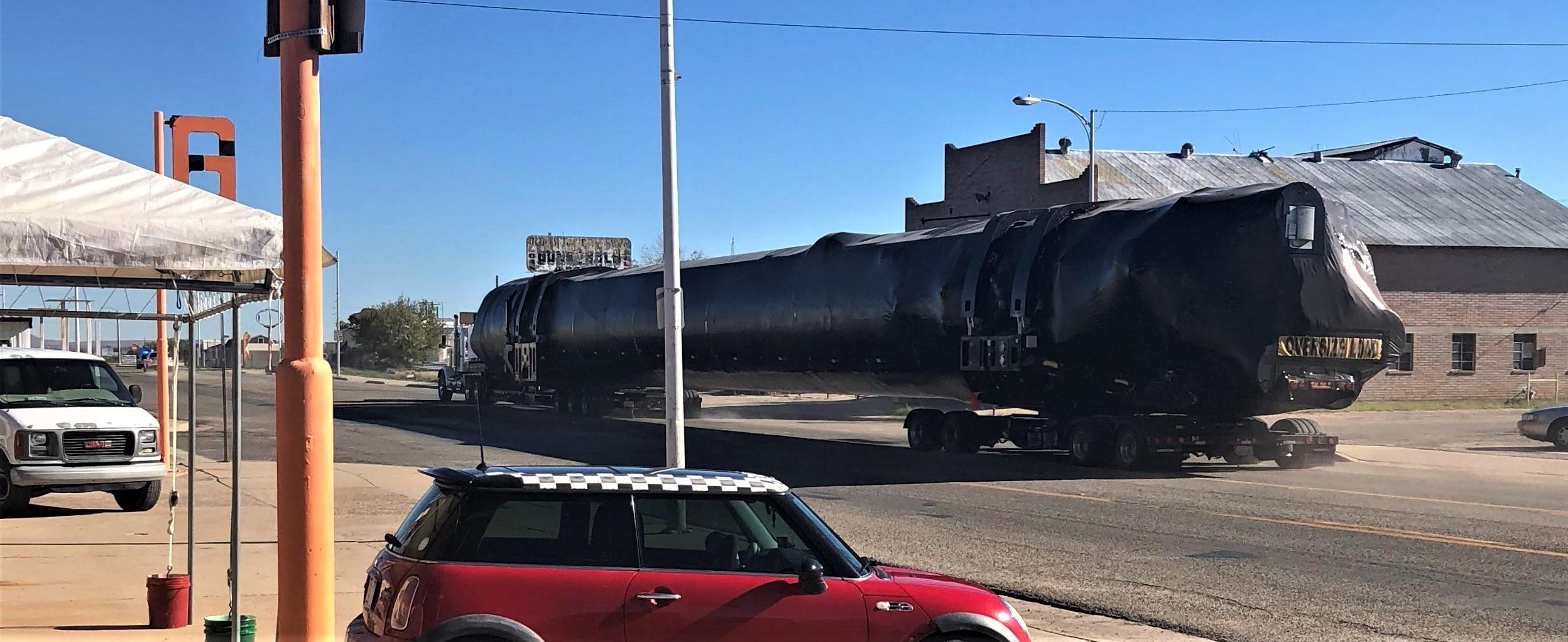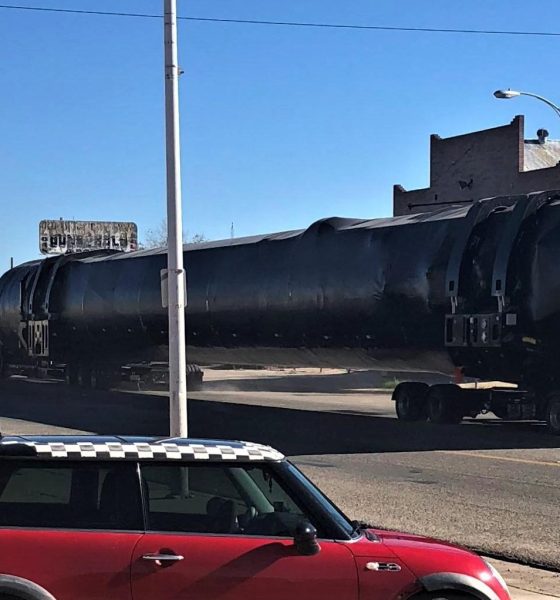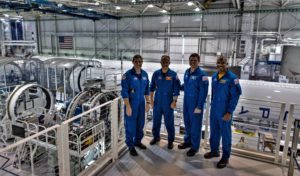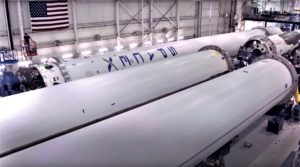

SpaceX
SpaceX hot-fires Crew Dragon’s Falcon 9 as separate rocket spied in Arizona
A SpaceX Falcon 9 booster has been spotted traveling eastbound through Wilcox, AZ, indicating a shipment from the company’s Hawthorne, CA rocket factory to its McGregor, TX facilities for hot-fire acceptance testing.
Captured by Reddit user codercotton on October 28th, this first stage (S1) is headed to Texas at the same time as SpaceX’s facilities appear to be wrapping up an extended test campaign with the Falcon 9 rocket stages that will launch an uncrewed Crew Dragon on the upgraded spacecraft’s first trip into orbit.
The team at our rocket development facility in McGregor, Texas completed a static fire test last night of the Falcon 9 booster that will launch SpaceX’s first demonstration mission for @NASA’s Commercial Crew Program – one step closer to flying astronauts to the @Space_Station! pic.twitter.com/iDYNoamCvU
— SpaceX (@SpaceX) October 27, 2018
This duo of Falcon 9 appearances highlights an unusual few months of what is often called “core spotting” by close followers of SpaceX. Typically, SpaceX ships and hot-fire tests a Falcon 9 booster every month, give or take roughly two weeks. It’s clear, however, that the imminent start of Crew Dragon launches under NASA’s Commercial Crew Program (CCP) has created some unique requirements with respect to both booster, upper stage, and individual engine testing in Texas.
For example, Falcon 9 B1051 – a new booster assigned to Crew Dragon’s first uncrewed demonstration launch (DM-1) – appears to have been testing in McGregor for the better part of three months, apparently including multiple hot-fire tests of the rocket. Prior to Commercial Crew, a nominal round of acceptance testing in McGregor would be expected to last between two and four weeks between arrival and departure. As such, spending three months or more in McGregor is very unusual, particularly for a brand-new booster like B1051.
B1051’s extended period of testing can likely be traced back to two main factors. At a more technical level, B1051 could be the first Falcon 9 Block 5 booster to have SpaceX’s upgraded COPVs (carbon-overwrapped pressure vessels) – bottles designed to hold helium and nitrogen at pressures around 5000 psi (35 MPa) – fully integrated on both the first and second stages. Perhaps not a major technical hurdle for SpaceX, this milestone is undoubtedly one of NASA’s most myopic and obsessive mountains-out-of-molehills in terms of the intense ‘certification’ burdens dumped on SpaceX over the course of CCP. SpaceX has apparently spent at least 1.5 years systematically designing, testing to destruction, and redesigning an in-house COPV, to the extent that CEO Elon Musk described the updated design as “by far the most advanced pressure vessel ever developed by humanity … It’s nuts.”
- In mid-September, CEO Elon Musk presented an update to BFR in front of Falcon 9 B1054 and at least three other visible boosters. (Eric Ralph)
- SpaceX’s NASA astronauts pose in front of the main Falcon assembly line, September 2018. (SpaceX)
- An October 2018 NASA video included this brief glimpse of SpaceX’s assembly line. (SpaceX)
- Falcon 9 shows off some of its COPVs in a tour of SpaceX’s Hawthorne factory. (SpaceX)
Juggling Falcon 9 tests
Despite the extreme lengths of testing apparently required for the Falcon 9s that will launch Crew Dragon, it can be concluded with some certainty that SpaceX has still managed to fit in normal tests of a number of non-Crew boosters, upper stages, and Merlins. According to the above SpaceX tweet, B1051 is clearly still in Texas and is unlikely to leave for Florida until November (several days are needed to prepare a booster for transport). However, a different booster was spotted heading from California to Texas just this morning.
Further, Falcon 9 booster B1054 – nearly complete and stationed in front of the only real exit route – was spotted in SpaceX’s Hawthorne factory in mid-September, while an unknown first stage was caught departing the factory for Texas roughly two weeks later. Finally, at the same time as the mystery booster was being trucked to Texas, an even more mysterious Falcon 9 – visibly sooty and thus flight-proven – was spotted inside one of SpaceX Hawthorne’s separate refurbishment hangars, with at least three Merlins removed from its octaweb. Perhaps this is somehow related to the Falcon 9 booster (missing four of nine Merlins) headed East on October 28th.
Finally, according to a member of the /r/SpaceX subreddit, a separate Falcon 9 booster apparently arrived at SpaceX’s Vandenberg, CA launch facilities on October 26th, perhaps Falcon 9 B1046.3 preparing to launch for the third time for Spaceflight’s SSO-A rideshare mission, NET November 19.
https://twitter.com/_TomCross_/status/1048483536917823488
As with most things SpaceX, definitive answers are exceedingly rare when it comes to day-to-day operations like Falcon 9 transportation and even official confirmation of the particular boosters involved with any given launch. Understandably, these more esoteric details are probably treated as “need-to-know” only, and while I and many others would love to know, we certainly don’t *need* to know.
For prompt updates, on-the-ground perspectives, and unique glimpses of SpaceX’s rocket recovery fleet check out our brand new LaunchPad and LandingZone newsletters!

Elon Musk
Elon Musk’s Biggest Revelations on AI, Robots, and the Future of Work from the Moonshots Podcast

Elon Musk’s appearance on the Moonshots with Peter Diamandis podcast was packed with bold predictions, candid admissions, and surprising tech insights. The nearly three-hour conversation covered everything from artificial intelligence to humanoid robots, geopolitics, and the future of work. Here are the top 10 most intriguing takeaways:
-
Aggressive AGI Timeline Predictions
Musk offered a detailed view on when artificial general intelligence (AGI) could emerge, suggesting it may arrive sooner than many expect, emphasizing both transformative potential and risks.
-
U.S. vs. China in the AI Race
He discussed the strategic competition between the United States and China over AI development, noting that geopolitical dynamics will shape how and who leads in the next decades.
-
Future of Job Markets
Musk touched on how AI and automation could reshape employment, predicting massive boosts in productivity alongside potential disruptions in traditional work structures.
-
Clean Energy Transition
A recurring theme was the role of clean energy in future economies, with Musk reiterating the importance of scaling sustainable power generation and storage.
-
Humanoid Robots Are Coming
On the podcast, Musk elaborated on Tesla’s work on humanoid robots, hinting at timelines and applications that go beyond factories to general-purpose assistance.
-
Tesla Roadster “Last Human-Driven Car”
Outside the core discussion topics, Musk teased features of the upcoming Tesla Roadster — calling it “the best of the last of the human-driven cars” and suggesting safety won’t be its main selling point.
-
The Role of AI in Clean Energy and Robotics
Linking AI to both energy optimization and robotics, Musk explained how smarter systems could accelerate decarbonization and task automation across industries.
-
U.S. Innovation Leadership
Musk argued that maintaining American leadership in key tech sectors like AI, space, and robotics should be a national priority, with thoughtful policy and investment.
-
Job Creation vs. Job Elimination
While acknowledging automation’s disruptive effects, he also outlined scenarios where new industries and opportunities could emerge, particularly in AI, space, and advanced manufacturing.
-
Long-Term Vision for Humanity
Throughout the conversation, Musk revisited his long-term philosophical views — including a belief in humanity’s responsibility to become a multi-planetary and technologically empowered species.
Whether you agree with Musk’s optimism or not, the podcast offers a window into the thinking of one of the most influential figures in tech today, in and why his visions continue to spark debate and inspiration.
Elon Musk
Starlink achieves major milestones in 2025 progress report
Starlink wrapped up 2025 with impressive growth, adding more than 4.6 million new active customers and expanding service to 35 additional countries, territories, and markets.

Starlink wrapped up 2025 with impressive growth, adding more than 4.6 million new active customers and expanding service to 35 additional countries, territories, and markets. The company also completed deployment of its first-generation Direct to Cell constellation, launching over 650 satellites in just 18 months to enable cellular connectivity.
SpaceX highlighted Starlink’s impressive 2025 progress in an extensive report.
Key achievements from Starlink’s 2025 Progress
Starlink connected over 4.6 million new customers with high-speed internet while bringing service to 35 more regions worldwide in 2025. Starlink is now connecting 9.2 million people worldwide. The service achieved this just weeks after hitting its 8 million customer milestone.
Starlink is now available in 155 markets, including areas that are unreachable by traditional ISPs. As per SpaceX, Starlink has also provided over 21 million airline passengers and 20 million cruise passengers with reliable high-speed internet connectivity during their travels.
Starlink Direct to Cell
Starlink’s Direct to Cell constellation, more than 650 satellites strong, has already connected over 12 million people at least once, marking a breakthrough in global mobile coverage.
Starlink Direct to Cell is currently rolled out to 22 countries and 6 continents, with over 6 million monthly customers. Starlink Direct to Cell also has 27 MNO partners to date.
“This year, SpaceX completed deployment of the first generation of the Starlink Direct to Cell constellation, with more than 650 satellites launched to low-Earth orbit in just 18 months. Starlink Direct to Cell has connected more than 12 million people, and counting, at least once, providing life-saving connectivity when people need it most,” SpaceX wrote.
Elon Musk
Starlink passes 9 million active customers just weeks after hitting 8 million
The milestone highlights the accelerating growth of Starlink, which has now been adding over 20,000 new users per day.

SpaceX’s Starlink satellite internet service has continued its rapid global expansion, surpassing 9 million active customers just weeks after crossing the 8 million mark.
The milestone highlights the accelerating growth of Starlink, which has now been adding over 20,000 new users per day.
9 million customers
In a post on X, SpaceX stated that Starlink now serves over 9 million active users across 155 countries, territories, and markets. The company reached 8 million customers in early November, meaning it added roughly 1 million subscribers in under seven weeks, or about 21,275 new users on average per day.
“Starlink is connecting more than 9M active customers with high-speed internet across 155 countries, territories, and many other markets,” Starlink wrote in a post on its official X account. SpaceX President Gwynne Shotwell also celebrated the milestone on X. “A huge thank you to all of our customers and congrats to the Starlink team for such an incredible product,” she wrote.
That growth rate reflects both rising demand for broadband in underserved regions and Starlink’s expanding satellite constellation, which now includes more than 9,000 low-Earth-orbit satellites designed to deliver high-speed, low-latency internet worldwide.
Starlink’s momentum
Starlink’s momentum has been building up. SpaceX reported 4.6 million Starlink customers in December 2024, followed by 7 million by August 2025, and 8 million customers in November. Independent data also suggests Starlink usage is rising sharply, with Cloudflare reporting that global web traffic from Starlink users more than doubled in 2025, as noted in an Insider report.
Starlink’s momentum is increasingly tied to SpaceX’s broader financial outlook. Elon Musk has said the satellite network is “by far” the company’s largest revenue driver, and reports suggest SpaceX may be positioning itself for an initial public offering as soon as next year, with valuations estimated as high as $1.5 trillion. Musk has also suggested in the past that Starlink could have its own IPO in the future.












